A sentinel in the autumnal sky, Jupiter marks its closest opposition since 1963.
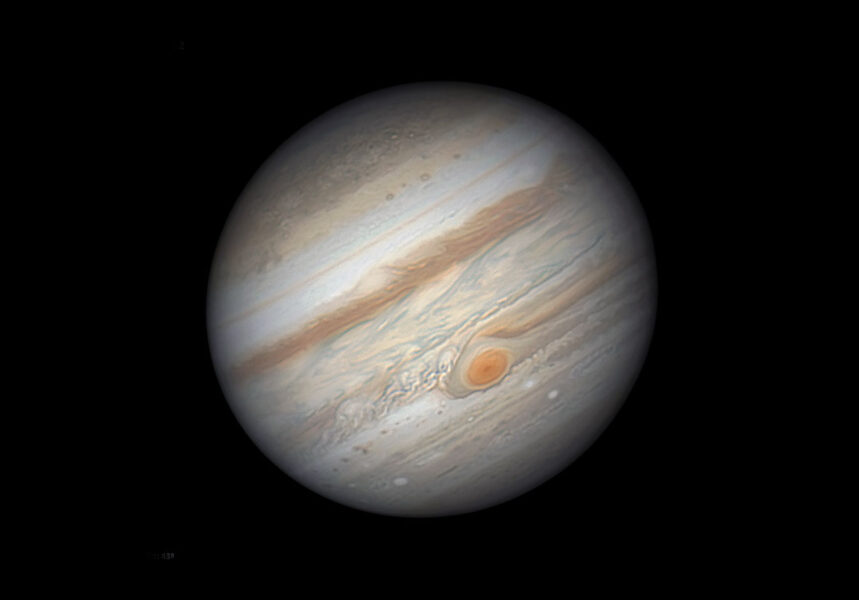
Enrico Enzmann and Damian Peach
Have you yet been asked about that "really bright star" in the eastern sky yet? I've already fielded a half-dozen eager queries. Of course, it's Jupiter, the biggest planet of all, and its brilliance is attracting a lot of attention this fall.
Jupiter reaches opposition on September 26th just 591 million kilometers (367 million miles) from Earth, the closest they'll pair for the year. Opposition distances vary depending on where the planet happens to be in its orbit when opposition comes around. The closer perihelion and opposition dates align, the closer the two planets will draw together and the brighter and larger the gas giant will shine.
This go-round, Jupiter lines up with Earth just four months shy of its January 21, 2023, perihelion. It hasn't been this close since the October 1963 opposition and won't be again until October 7, 2129. That's why it appears exceptionally large (49.9″ across) and bright (magnitude –2.9). But that's only half the story.
After digging coal in the mines of Sagittarius and Capricornus for the past couple of years, Jupiter has risen to the celestial equator in Pisces. From latitude 40° north it now beams from an altitude of 50° at meridian passage with minimal atmospheric extinction. The mighty orb also dominates a large region of the sky with few bright stars. Fomalhaut (magnitude 1.2) and Saturn (+0.5), located 35° and 44° away, respectively, make only feeble competitors. Taken together you can see why Jupiter's having a moment in 2022.
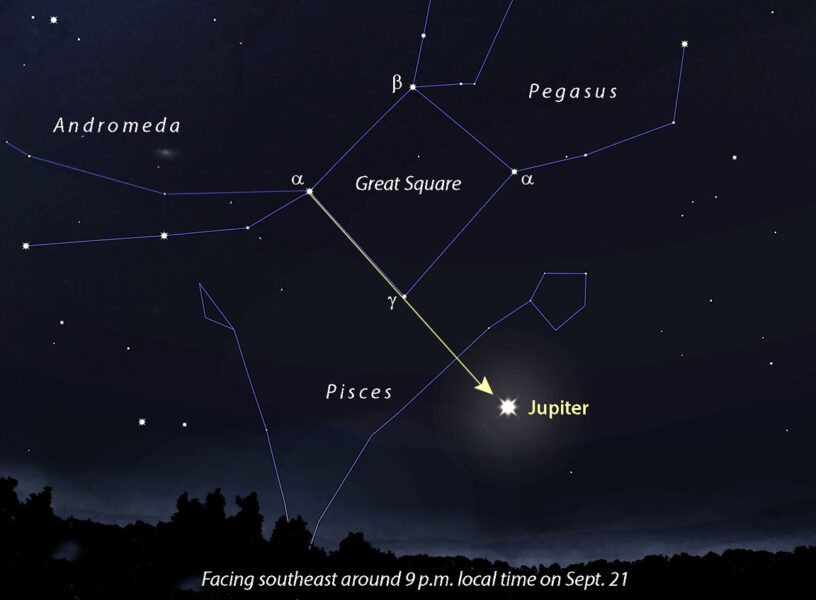
Stellarium
Here's a fun naked-eye project. Now through late November, Jupiter moves westward in retrograde motion below the Great Square of Pegasus across the faint stars of Pisces. Can you detect its movement in a day? Two days? Fortunately, we have an excellent measuring stick: Alpha (α) Andromedae, better known as Alpheratz, and Gamma (γ) Pegasi, or Algenib. The pair form the eastern side of the Great Square. On September 21st, Jupiter will appear almost exactly below the two stars. A night or two later, you should be able to detect a slight misalignment. Let us know your result.
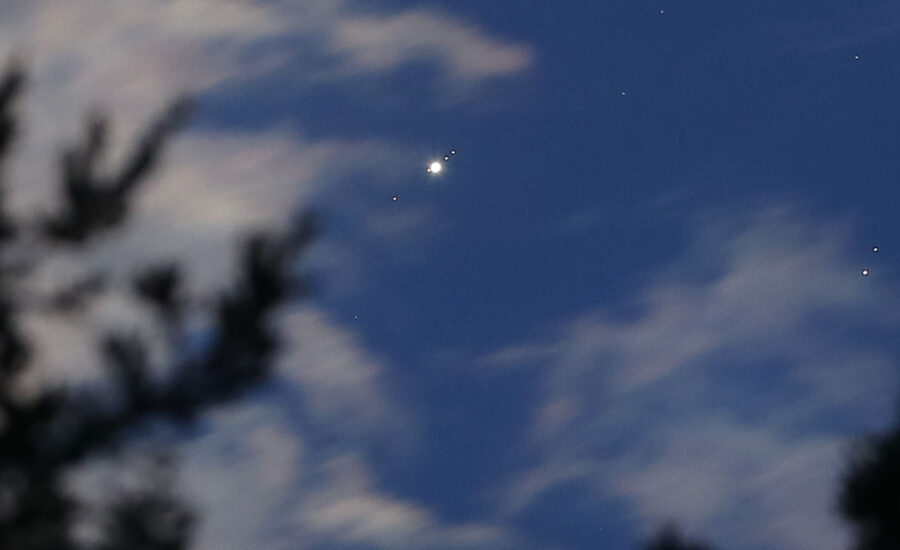
Bob King
For a much more difficult catch try spotting either Ganymede (magnitude 4.4 at opposition) or Callisto (5.4), the planet's two bright outer moons, without optical aid. At maximum elongation this apparition Ganymede stands off about 5.6′ from the glaring planet and Callisto 10.5′. Pick a time when either or both reach maximum elongation using Sky & Telescope's Jupiter's Moons tool. Then hide Jupiter behind a roof line, power pole, mountain top, or tree trunk and use averted vision till it hurts. Confirm your observation with binoculars after you're sure you've spotted them.
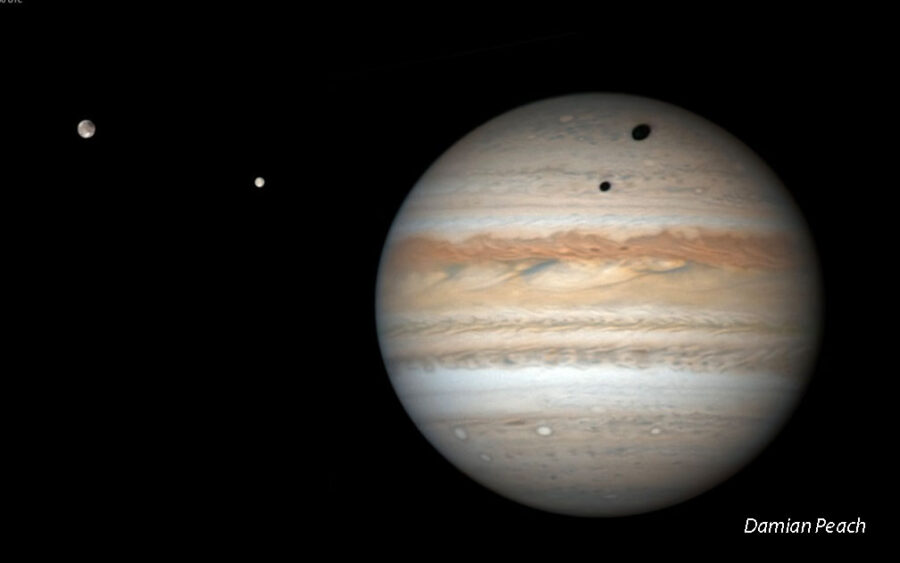
Damian Peach
The Jupiter's Moons calculator also displays daily eclipses, occultations, transits, and shadow transits. An eclipse occurs when a moon passes into Jupiter's shadow; an occultation takes place when a moon slips behind Jupiter from our perspective. The moons also transit or pass in front of the planet and trail shadows on its cloud tops called shadow transits. These events are so much fun to watch. To make sure I don't miss the juicy ones (shadow transits are my favorite) I run the simulations, write down the dates and times, and then tuck that information into my eyepiece case.
Last year, the Earth crossed the orbital plane of the four Galilean moons. Since the bright moons orbit closely within Jupiter's equatorial plane, we watched them shuttle back and forth on either side of the planet in pretty much a straight line. This year, the orbits are no longer coplanar, and the moons trace out narrow ellipses around the Jovian globe. When near Jupiter, they can appear remarkably out of line, producing all manner of improbable configurations. One night a few weeks ago, they enclosed the planet in an attractive trapezoid. The quartet will still occasionally align in a tidy line but only when all lie at or near maximum elongation.
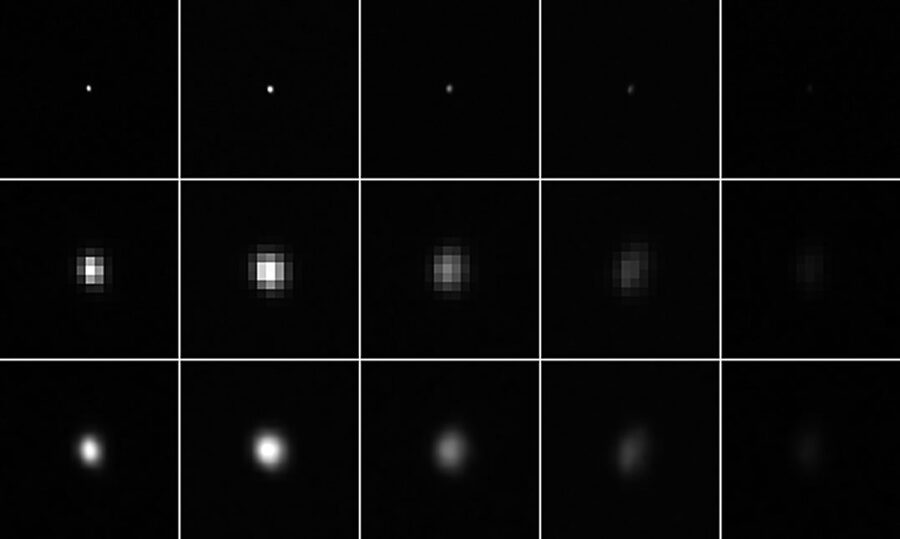
NASA / JHUAPL / SRI
Besides the four Galilean moons, it's possible to see a fifth Jovian satellite, Himalia. At opposition it glows feebly at magnitude 14.5 about 23′ north of Jupiter, close enough to be swamped by the planet's glare. Better to wait until early November when the moon stands off about 45′ to the west-southwest of Jupiter. Greatest elongation of about 1° occurs in early December, when Himalia will be a few tenths of a magnitude fainter. You can pinpoint the moon's position by using the SkySafari app, Guide 9.1, the Minor Planet Center's Natural Satellites Ephemeris Service, or go to the JPL Horizons System site. With the latter two you can create your own ephemeris, then hand-plot the moon's location on paper or in Stellarium. Planetary photographers can shoot for close-in Amalthea (magnitude 13.9) and fainter but more distant Elara (magnitude 16.5).
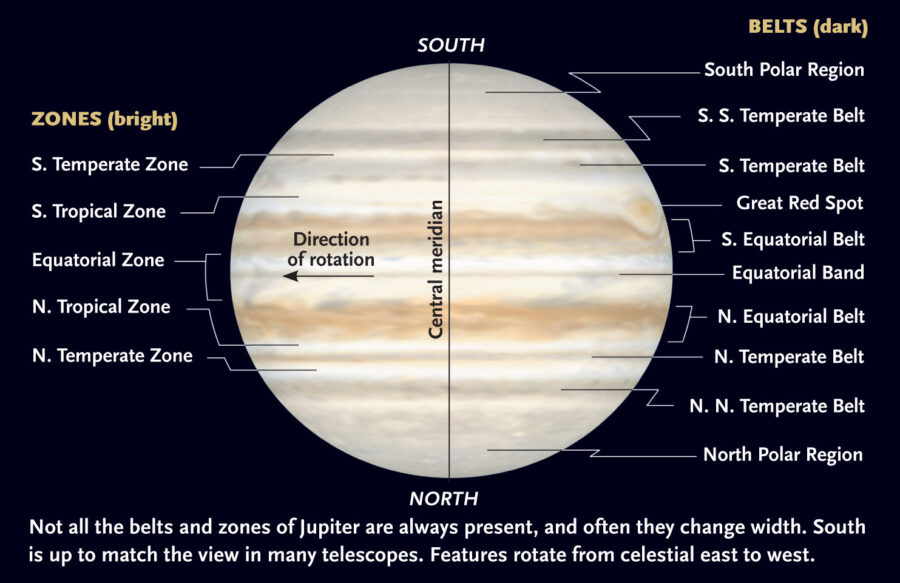
Sky & Telescope Illustration
If you like zebras you'll love Jupiter. The planet presents a wealth of detail through the telescope including its famous dark stripes called belts that alternate with paler zones. Even an 80-mm (3-inch) scope will show the two most prominent belts, the North Equatorial Belt (NEB) and South Equatorial Belt (SEB). This season, I've observed that the NEB appears noticeably narrower and darker than the SEB on the hemisphere it shares with the Great Red Spot (GRS), while on the opposite side of the globe, the two look more alike.

NASA / JPL-Caltech / SwRI / MSSS / Gerald Eichstadt / Justin Cowart
Between the two belts lies the bright Equatorial Zone (EZ), home to looping, gray festoons that are visible at magnifications of 150× or more. A #80A blue filter will reduce glare and enhance the contrast of the reddish belts and festoons as well as assist in finding the Great Red Spot. Although the GRS is an attractive orange-red, it doesn't exactly jump out at you. Wait until the Spot appears front and center — within an hour on either side of Jupiter's central meridian — and use 100× or more. You find the times of its meridian passage at Sky & Telescope's Great Red Spot Transit Times calculator.
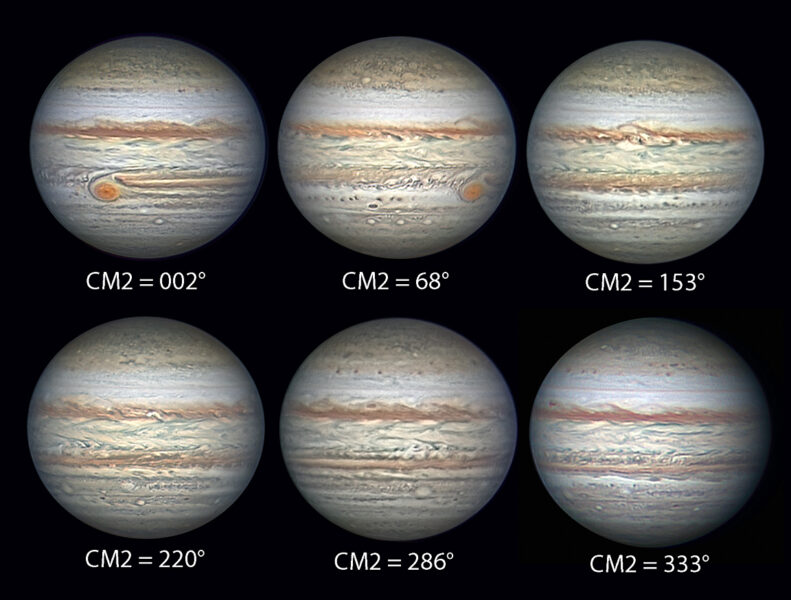
Ed Grafton
Shrinkage is one reason for the Spot's decreased visibility. When Voyager 2 flew by in 1979, it recorded a width at around 25,000 kilometers, or about twice as big as the Earth. It's now closer to 1.3 times as large. A monster Jovian hurricane with winds reaching 680 kilometers per hour (420 miles per hour), the GRS has persisted for hundreds of years.
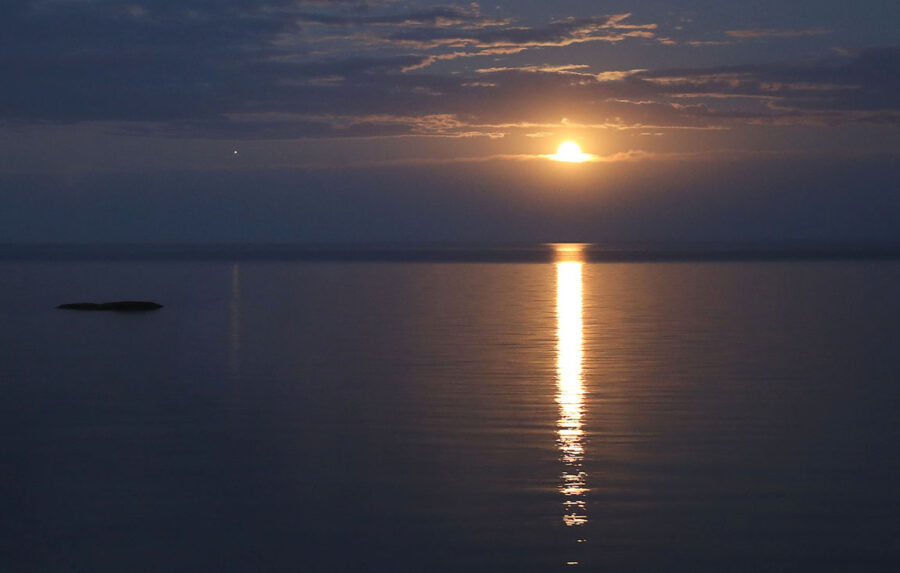
Bob King
On nights of good seeing you can explore beyond the equatorial belts, the prominent South Tropical Zone (STZ), and North Temperature Zone (NTZ) in search of the North Temperate Belt (NTB) and others. Both polar regions appear ashen gray and are frequently bounded by partial belts. Given its fast rotation period of 9.9 hours, there's always something new coming over the Jovian limb, so it makes sense to revisit the planet more than once each night you're out. Jupiter's clouds and weather are subject to continual change. Storms blow up and fade. Belts darken or disappear. Even the Great Red Spot's color can be unpredictable. What's the forecast for Jupiter tonight? Go have a look!
 13
13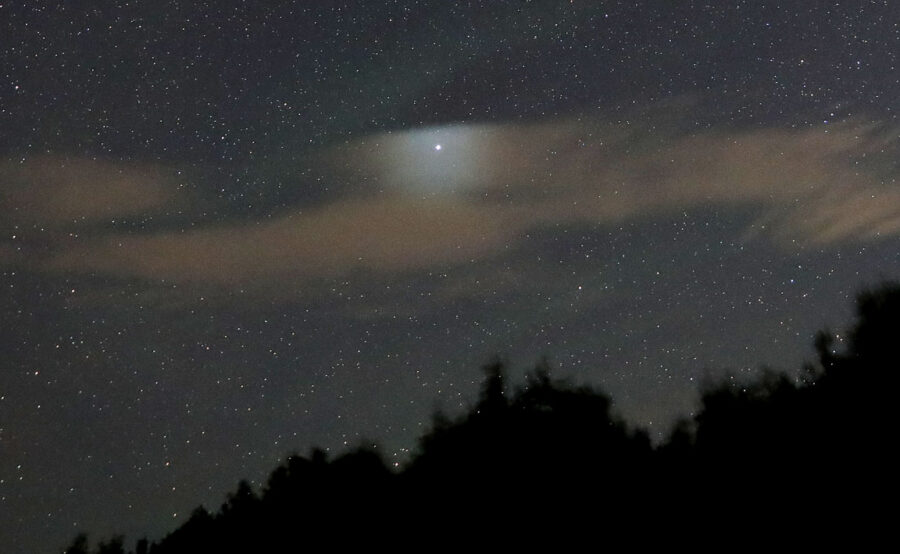

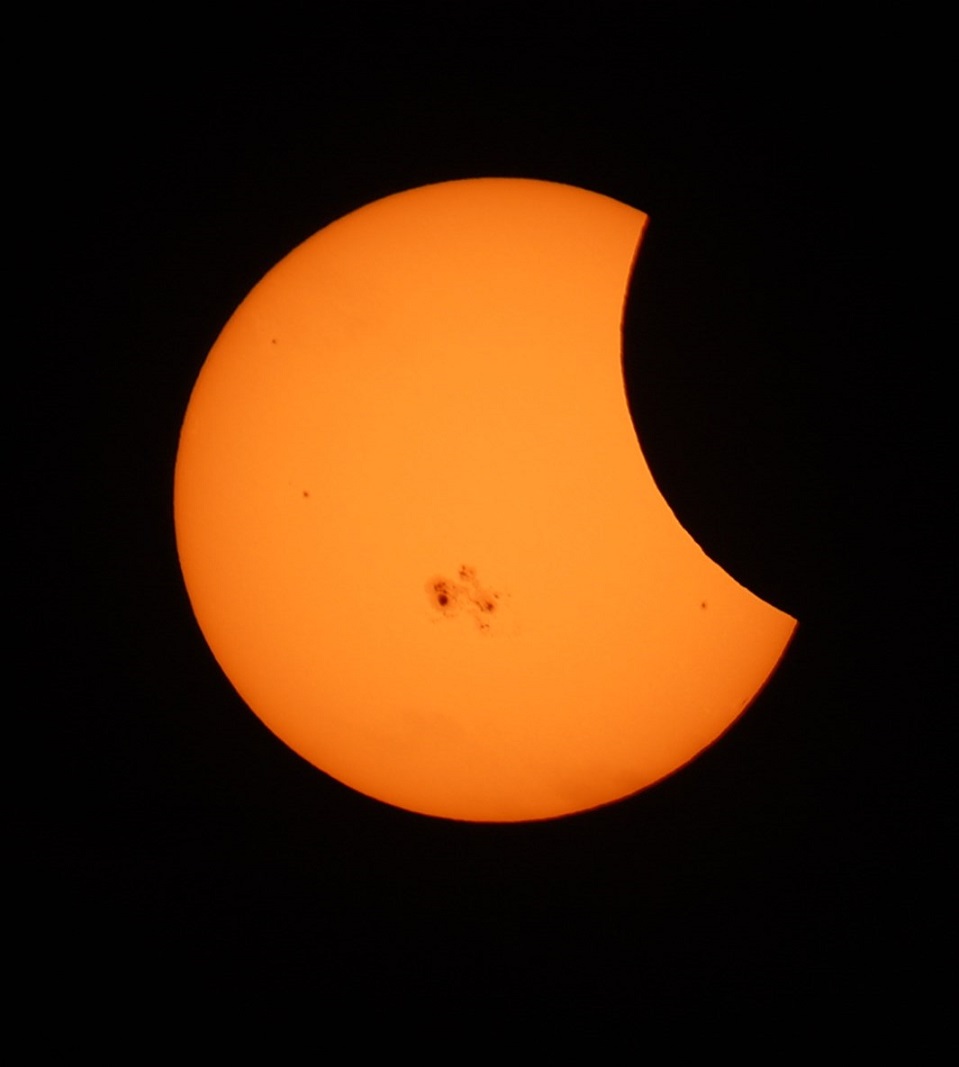








Comments
Rod
September 21, 2022 at 10:50 am
Bob King, very good report. I posted a Jupiter observation at
https://skyandtelescope.org/astronomy-news/observing-news/this-weeks-sky-at-a-glance-september-16-24-2/
Ganymede transit and shadow transit last night. Ganymede was visible as a small round or disk shape moon, not just a tiny point of light at 200x as the moon approached egress and closer to the limb. Friday night looks good for me here in MD, so I plan to use my 10-inch Newtonian along with my 90-mm refractor telescope for some more Jupiter fun 🙂
You must be logged in to post a comment.
Bob KingPost Author
September 21, 2022 at 11:01 am
Hi Rod,
Thank you, and I always enjoy hearing about your observations. By good fortune, my class and I also observed the same shadow transit last night. It looked enormous! I didn't have time for study, but now that Ganymede's shadow lies well south of the equator it might be fun to use high magnification to see if we can detect its distorted shape (see photo above) caused by the curvature of Jupiter's globe.
You must be logged in to post a comment.
Anthony Barreiro
September 21, 2022 at 5:09 pm
Jupiter has been remarkably bright! I've had some great views through my 60 mm f/5.5 refractor at 94x. The great red spot has been discernible with a light blue filter.
Just curious, does the animation of the great red spot have north or south up? Either way, a southern hemisphere anticyclone rotates counterclockwise.
You must be logged in to post a comment.
Bob KingPost Author
September 21, 2022 at 9:33 pm
Hi Anthony,
With it being counterclockwise in the animation, north is up. I compared this one with Voyager's animation showing Jupiter full disk to be sure, and they match. Here's that link in case you haven't seen it:
https://en.wikipedia.org/wiki/Great_Red_Spot#/media/File:790106-0203_Voyager_58M_to_31M_reduced.gif
You must be logged in to post a comment.
Anthony Barreiro
September 22, 2022 at 9:26 pm
Thank you Bob. But I still think that whether north or south is up, it would still be rotating counterclockwise. If you hang a wall clock with 6 o'clock at the top, the hands still move clockwise.
You must be logged in to post a comment.
Bob KingPost Author
September 24, 2022 at 12:10 am
Anthony,
Ha! Yes, of course that makes sense. I went back and dug up the original file on the Juno site and compared it to high quality photos of the GRS taken by amateurs around that time. North is up.
You must be logged in to post a comment.
Anthony Barreiro
September 24, 2022 at 5:36 pm
Thank you. I appreciate it, and I hope the research wasn't too much bother.
You must be logged in to post a comment.
Bob KingPost Author
September 25, 2022 at 10:43 am
Anthony,
Not at all. You're welcome!
You must be logged in to post a comment.
mary beth
September 21, 2022 at 11:02 pm
Fantastic photos Bob! Very informative and interesting. Would a planet rising with the sun be considered helical, like with stars?
You must be logged in to post a comment.
Bob KingPost Author
September 22, 2022 at 10:38 am
Thank you, Mary Beth. I appreciate that. Yes, the same applies to planets — when either first becomes visible in the eastern sky not long before sunrise.
You must be logged in to post a comment.
Chris-Schur
September 24, 2022 at 5:05 pm
Very informative article Bob, what I noticed first was on that top photo how small the GRS looks these days. I remember as a kid looking at the spot in my 4.5 inch newtonian and how much larger it was back then. Then again, when your 4 foot tall, everything seems big....
You must be logged in to post a comment.
Bob KingPost Author
September 25, 2022 at 10:46 am
Hi Chris,
It really was bigger back then. I remember from the 1960s, when it was not only larger but also darker. While colorful this apparition, its color depth is less than at some seasons, lessening contrast visually.
You must be logged in to post a comment.
Rod
September 28, 2022 at 7:42 am
On the 26-Sep I had too many clouds to view Jupiter at opposition, however, last night was very good. Here is a note from my log 🙂 Indeed, Jupiter is closer.
Observed 2100-2330 EDT/0100-0330 UT 28-Sep. First Quarter Moon 03-Oct-2022 0014 UT. Some excellent views of Saturn and Jupiter tonight using 90-mm refractor at 200x and XT10i at 214X views. I used #17 polarizer filter on the 90-mm refractor telescope. XT10i, #12 Yellow filter and #58 Green filter. Numerous cloud bands visible at Jupiter along with the Galilean moons. Ganymede closer to Jupiter's limb in angular separation and by 2300 EDT, the XT10i at 214x I could see as a small disk shape or circular moon, Callisto also. Ganymede transit of Jupiter at 0008 EDT or 0012 EDT (0408 UT or 0412 UT), depending upon the tool used (S&T online Tools or September 2022 magazine issue). I did not stay out to observe the Ganymede transit of Jupiter and shadow transit. Near 2200 EDT, Stellarium angle mode showed a bit more than 7 arcminute angular separation from Jupiter’s limb for Callisto and Ganymede very close to 25 arcsecond separation. Stellarium shows their angular sizes as well as angular separation. Ganymede 1.84 arcsecond and Callisto 1.68 arcsecond tonight. At 200x using the 90-mm refractor, Ganymede appeared circular shape like a small moon with the polarizing filter. The XT10i at 214x using #12 Yellow filter did very well for the Galilean moons, especially as Jupiter approached transit time near 0055 EDT. Better elevation angle and position in the sky. Earlier in the evening some altocumulus clouds passed causing problems. About 2118 EDT, I observed a meteor streak SSE near Saturn, about as bright. Using the 90-mm refractor, I could see Titan, with the XT10i I could see 5 Saturnian moons. Titan and Rhea, Enceladus closer to Saturn limb in angular separation, Tethys and Dione. A lovely evening looking at Saturn and Jupiter. Winds NW 8 knots and temperature 14C. Some bucks were out in the woods tonight.
You must be logged in to post a comment.
You must be logged in to post a comment.